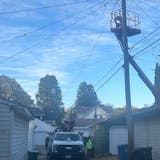A federal plan to buy 56,000 acres of state land inside the Boundary Waters Canoe Area Wilderness saw a small but promising bit of progress recently that could help solve a long-standing land ownership dilemma in the wilderness area.
The U.S. Forest Service, searching for millions of dollars to help it buy some of the state land that was locked up in the BWCA when the federal wilderness area was created in 1978, was invited recently to apply for funds from a federal pool of money derived from offshore oil and gas leases.
The final application isn't due until August, but news of a possible funding source comes amid new progress in talks that go back decades.
"The feeling is that we've got some momentum going here," said Kris Reichenbach, public affairs officer for the Superior National Forest.
The land dispute traces its roots back to 1849, when the U.S. government gave Minnesota the first of some 8.3 million acres to pay for schools. Most of the "school trust land" was eventually sold or leased, but 86,000 acres remain inside the BWCA. It has long been a source of friction between conservationists and those who would like to see logging and mining revenue sent to the state.
Various compromises over the years have included a swap of the school trust lands for federal land elsewhere.
A 2012 proposal to do an acre-for-acre swap passed the U.S. House but never got a vote in the U.S. Senate.
A compromise plan has since emerged that would see roughly a third of the school trust lands swapped for federal land, with the federal government purchasing the remaining two-thirds of BWCA school trust land.

